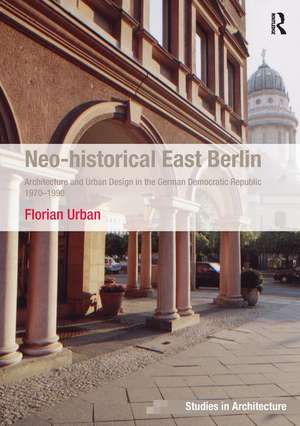Neo-historical East Berlin: Architecture and Urban Design in the German Democratic Republic 1970-1990: Ashgate Studies in Architecture
Autor Florian Urbanen Limba Engleză Paperback – 23 sep 2016
| Toate formatele și edițiile | Preț | Express |
|---|---|---|
| Paperback (1) | 340.33 lei 6-8 săpt. | |
| Taylor & Francis – 23 sep 2016 | 340.33 lei 6-8 săpt. | |
| Hardback (1) | 824.53 lei 6-8 săpt. | |
| Taylor & Francis – 8 dec 2009 | 824.53 lei 6-8 săpt. |
Din seria Ashgate Studies in Architecture
- 8%
 Preț: 390.34 lei
Preț: 390.34 lei - 28%
 Preț: 821.14 lei
Preț: 821.14 lei - 24%
 Preț: 329.91 lei
Preț: 329.91 lei - 30%
 Preț: 768.30 lei
Preț: 768.30 lei - 11%
 Preț: 362.88 lei
Preț: 362.88 lei - 14%
 Preț: 325.34 lei
Preț: 325.34 lei - 24%
 Preț: 321.88 lei
Preț: 321.88 lei - 25%
 Preț: 826.84 lei
Preț: 826.84 lei - 30%
 Preț: 776.81 lei
Preț: 776.81 lei -
 Preț: 449.41 lei
Preț: 449.41 lei - 30%
 Preț: 770.74 lei
Preț: 770.74 lei - 28%
 Preț: 823.99 lei
Preț: 823.99 lei - 22%
 Preț: 324.16 lei
Preț: 324.16 lei - 28%
 Preț: 881.28 lei
Preț: 881.28 lei - 14%
 Preț: 338.33 lei
Preț: 338.33 lei -
 Preț: 469.34 lei
Preț: 469.34 lei - 28%
 Preț: 878.01 lei
Preț: 878.01 lei - 12%
 Preț: 328.00 lei
Preț: 328.00 lei - 31%
 Preț: 767.47 lei
Preț: 767.47 lei - 18%
 Preț: 1012.89 lei
Preț: 1012.89 lei -
 Preț: 469.34 lei
Preț: 469.34 lei - 28%
 Preț: 826.84 lei
Preț: 826.84 lei - 26%
 Preț: 850.54 lei
Preț: 850.54 lei - 25%
 Preț: 710.66 lei
Preț: 710.66 lei - 13%
 Preț: 338.33 lei
Preț: 338.33 lei - 31%
 Preț: 767.67 lei
Preț: 767.67 lei - 16%
 Preț: 338.33 lei
Preț: 338.33 lei - 26%
 Preț: 821.82 lei
Preț: 821.82 lei - 26%
 Preț: 821.53 lei
Preț: 821.53 lei - 28%
 Preț: 827.64 lei
Preț: 827.64 lei - 30%
 Preț: 768.69 lei
Preț: 768.69 lei - 28%
 Preț: 822.11 lei
Preț: 822.11 lei - 25%
 Preț: 799.76 lei
Preț: 799.76 lei - 28%
 Preț: 823.08 lei
Preț: 823.08 lei - 28%
 Preț: 826.01 lei
Preț: 826.01 lei - 30%
 Preț: 769.51 lei
Preț: 769.51 lei
Preț: 340.33 lei
Preț vechi: 395.34 lei
-14% Nou
Puncte Express: 510
Preț estimativ în valută:
65.13€ • 67.75$ • 53.77£
65.13€ • 67.75$ • 53.77£
Carte tipărită la comandă
Livrare economică 14-28 aprilie
Preluare comenzi: 021 569.72.76
Specificații
ISBN-13: 9781138252936
ISBN-10: 113825293X
Pagini: 296
Dimensiuni: 174 x 246 mm
Greutate: 0.55 kg
Ediția:1
Editura: Taylor & Francis
Colecția Routledge
Seria Ashgate Studies in Architecture
Locul publicării:Oxford, United Kingdom
ISBN-10: 113825293X
Pagini: 296
Dimensiuni: 174 x 246 mm
Greutate: 0.55 kg
Ediția:1
Editura: Taylor & Francis
Colecția Routledge
Seria Ashgate Studies in Architecture
Locul publicării:Oxford, United Kingdom
Cuprins
Contents: Introduction; Neo-historical East Berlin; Obsolescence becomes obsolete: Arnimplatz, Arkonaplatz and beyond; 'Rekonstuktion': the Spandauer Vorstadt neighborhood; Prefab old town: Nikolaiviertel; 'Restauration 1900': the Prenzlauer Berg district; Experiencing the center: Freidrichstraße; Re-feeling history: the Platz der Akademie (Gendarmenmarkt); Conclusion: faux past; Appendices; Bibliography; Index.
Notă biografică
Florian Urban is a Lecturer at the Center for Metropolitan Studies, Technische Universität Berlin, Germany
Recenzii
'Florian Urban's Neo-historical East Berlin adds a fascinating new dimension to the central debates about post-war German identity. By examining the legacy of tenement housing and the struggles over modernity and contested ideologies, it uses architecture and urbanism as a window to understand the larger cultural, social, and political movements of the era.' Lawrence J. Vale, Massachusetts Institute of Technology, USA 'Central to Florian Urban's thesis are the great projects of town planning in the last phase of the GDR. Urban gives us a sober and penetrating insight into the political and philosophical background behind these projects, opening up a new understanding of modernity's complex relationship with the times.' Mark Jarzombek, Massachusetts Institute of Technology, USA 'Florian Urban's book Neo-historical East Berlin is an outstanding work. It is the first thorough treatment of city design in the late phase of the German Democratic Republic. Urban shows that despite the antagonistic political systems in East and West Berlin the principles of urban design were in many respects surprisingly similar. The book is a major contribution to urban design history.' Heinz Reif, Center for Metropolitan Studies (Berlin), Germany '...Urban brings a fresh perspective to East German Studies at a time when there is enough historical perspective to begin to examine the GDR more objectively.' German Studies Review
Descriere
Drawing from recently released archival sources and interviews with former key government officials, decision-makers and architects, this book sheds light not only on this unique program of postmodern design, but also on the debates which were taking place with the Socialist government.

